Room Temperature Chemiresistive Gas Sensors Based on 2D MXenes
Abstract
:1. Introduction
2. MXenes: A Brief Introduction
2.1. Pristine MXene Gas Sensors
2.1.1. Delaminated MXene Gas Sensors
2.1.2. Multilayered MXene Gas Sensors
2.2. Composite MXene Gas Sensors
2.2.1. MXene–Metal Oxide Composites
2.2.2. MXene-TMD Composites
2.2.3. MXene-Conducting Polymers Composites
2.2.4. Ternary Composites
2.2.5. Other MXene-Based Composites
2.2.6. Doped/Decorated MXenes
3. Conclusions and Outlooks
Author Contributions
Funding
Institutional Review Board Statement
Informed Consent Statement
Data Availability Statement
Conflicts of Interest
References
- Mirzaei, A.; Lee, J.H.; Majhi, S.M.; Weber, M.; Bechelany, M.; Kim, H.W.; Kim, S.S. Resistive gas sensors based on metal-oxide nanowires. J. Appl. Phys. 2019, 126, 241102. [Google Scholar] [CrossRef]
- Mirzaei, A.; Neri, G. Microwave-assisted synthesis of metal oxide nanostructures for gas sensing application: A review. Sens. Actuators B Chem. 2016, 237, 749–775. [Google Scholar] [CrossRef]
- Shooshtari, M.; Vollebregt, S.; Vaseghi, Y.; Rajati, M.; Pahlavan, S. The sensitivity enhancement of TiO2-based VOCs sensor decorated by gold at room temperature. Nanotechnology 2023, 34, 255501. [Google Scholar] [CrossRef]
- Joshi, N.; Hayasaka, T.; Liu, Y.; Liu, H.; Oliveira, O.N.; Lin, L. A review on chemiresistive room temperature gas sensors based on metal oxide nanostructures, graphene and 2D transition metal dichalcogenides. Mikrochim. Acta 2018, 185, 213. [Google Scholar] [CrossRef]
- Jiang, Q.; Lei, Y.; Liang, H.; Xi, K.; Xia, C.; Alshareef, H.N. Review of MXene electrochemical microsupercapacitors. Energy Storage Mater. 2020, 27, 78–95. [Google Scholar] [CrossRef]
- Sreenilayam, S.P.; Ahad, I.U.; Nicolosi, V.; Brabazon, D. MXene materials based printed flexible devices for healthcare, biomedical and energy storage applications. Mater. Today 2021, 43, 99–131. [Google Scholar]
- Ma, C.; Ma, M.G.; Si, C.; Ji, X.X.; Wan, P. Flexible MXene-based composites for wearable devices. Adv. Fun. Mater. 2021, 31, 2009524. [Google Scholar] [CrossRef]
- Li, X.; Huang, Z.; Shuck, C.E.; Liang, G.; Gogotsi, Y.; Zhi, C. MXene chemistry, electrochemistry and energy storage applications. Nat. Rev. Chem. 2022, 6, 389–404. [Google Scholar] [CrossRef]
- Bhat, A.; Anwer, S.; Bhat, K.S.; Mohideen, M.I.H.; Liao, K.; Qurashi, A. Prospects challenges and stability of 2D MXenes for clean energy conversion and storage applications. NPJ 2D Mater. Appl. 2021, 5, 61. [Google Scholar] [CrossRef]
- Murali, G.; Reddy Modigunta, J.K.; Park, Y.H.; Lee, J.H.; Rawal, J.; Lee, S.Y.; In, I.; Park, S.J. A review on MXene synthesis, stability, and photocatalytic applications. ACS Nano 2022, 16, 13370–13429. [Google Scholar] [CrossRef]
- Murali, G.; Reddy Modigunta, J.K.; Park, Y.H.; Lee, J.H.; Lee, S.Y.; Park, S.J.; In, I. A review on MXenes: New-generation 2D materials for supercapacitors. Sustain. Energy Fuels 2021, 5, 5672–5693. [Google Scholar]
- Bhardwaj, R.; Hazra, A. MXene-based gas sensors. J. Mater. Chem. C 2021, 9, 15735–15754. [Google Scholar] [CrossRef]
- Mehdi Aghaei, S.; Aasi, A.; Panchapakesan, B. Experimental and theoretical advances in MXene-based gas sensors. ACS Omega 2021, 6, 2450–2461. [Google Scholar] [CrossRef] [PubMed]
- Zhang, H.F.; Xuan, J.Y.; Zhang, Q.; Sun, M.L.; Jia, F.C.; Wang, X.M.; Yin, G.C.; Lu, S.Y. Strategies and challenges for enhancing performance of MXene-based gas sensors: A review. Rare Met. 2022, 41, 3976–3999. [Google Scholar] [CrossRef]
- Devaraj, M.; Rajendran, S.; Hoang, T.K.; Soto-Moscoso, M. A review on MXene and its nanocomposites for the detection of toxic inorganic gases. Chemosphere 2022, 302, 134933. [Google Scholar] [CrossRef]
- Xia, Q.; Fan, Y.; Li, S.; Zhou, A.; Shinde, N.; Mane, R.S. MXene-based chemical gas sensors: Recent developments and challenges. Diam. Relat. Mater. 2022, 131, 109557. [Google Scholar] [CrossRef]
- Nahirniak, S.; Saruhan, B. MXene heterostructures as perspective materials for gas sensing applications. Sensors 2022, 22, 972. [Google Scholar] [CrossRef]
- Riazi, H.; Taghizadeh, G.; Soroush, M. MXene-based nanocomposite sensors. ACS Omega 2021, 6, 11103–11112. [Google Scholar] [CrossRef]
- Pei, Y.; Zhang, X.; Hui, Z.; Zhou, J.; Huang, X.; Sun, G.; Huang, W. Ti3C2TX MXene for sensing applications: Recent progress, design principles, and future perspectives. ACS Nano 2021, 15, 3996–4017. [Google Scholar] [CrossRef]
- Deshmukh, K.; Kovářík, T.; Pasha, S.K. State of the art recent progress in two dimensional MXenes based gas sensors and biosensors: A comprehensive review. Coord. Chem. Rev. 2020, 424, 213514. [Google Scholar]
- Sinha, A.; Zhao, H.; Huang, Y.; Lu, X.; Chen, J.; Jain, R. MXene: An emerging material for sensing and biosensing. TrAC Tren. Anal. Chem. 2018, 105, 424–435. [Google Scholar]
- Otgonbayar, Z.; Oh, W.C. Comprehensive and multi-functional MXene based sensors: An updated review. FlatChem 2023, 40, 100524. [Google Scholar]
- Ta, Q.T.H.; Thakur, D.; Noh, J.S. Design of functional Ti3C2Tx MXene for gas sensors and energy harvesting: A review. Chemosensors 2023, 11, 477. [Google Scholar]
- Jin, C.; Bai, Z. MXene-based textile sensors for wearable applications. ACS Sens. 2022, 7, 929–950. [Google Scholar] [CrossRef] [PubMed]
- Radhakrishnan, S.; Rout, C.S. Recent developments in 2D MXene based materials for next generation room temperature NO2 gas sensors. Nanoscale Adv. 2023, 5, 4649–4669. [Google Scholar]
- Peng, B.; Huang, X. Research status of gas sensing performance of Ti3C2Tx-based gas sensors: A mini review. Fron. Chem. 2022, 10, 1037732. [Google Scholar] [CrossRef]
- Gautam, R.; Marriwala, N.; Devi, R. A review: Study of MXene and graphene together. Meas. Sens. 2022, 25, 100592. [Google Scholar] [CrossRef]
- Lee, E.; Kim, D.J. Recent exploration of two-dimensional MXenes for gas sensing: From a theoretical to an experimental view. J. Electrochem. Soc. 2020, 167, 037515. [Google Scholar] [CrossRef]
- Xin, M.; Li, J.; Ma, Z.; Pan, L.; Shi, Y. MXenes and their applications in wearable sensors. Front. Chem. 2020, 8, 297. [Google Scholar] [CrossRef]
- Sivasankarapillai, V.S.; Sharma, T.S.K.; Hwa, K.Y.; Wabaidur, S.M.; Angaiah, S.; Dhanusuraman, R. MXene based sensing materials: Current status and future perspectives. ES Energy Environ. 2022, 15, 4–14. [Google Scholar] [CrossRef]
- Simonenko, E.P.; Simonenko, N.P.; Mokrushin, A.S.; Simonenko, T.L.; Gorobtsov, P.Y.; Nagornov, I.A.; Korotcenkov, G.; Sysoev, V.V.; Kuznetsov, N.T. Application of titanium carbide MXenes in chemiresistive gas sensors. Nanomaterials 2023, 13, 850. [Google Scholar]
- Tran, V.A.; Tran, N.T.; Doan, V.D.; Nguyen, T.Q.; Thi, H.H.P.; Vo, G.N. Application prospects of MXenes materials modifications for sensors. Micromachines 2023, 14, 247. [Google Scholar] [CrossRef]
- Li, Q.; Li, Y.; Zeng, W. Preparation and application of 2D MXene-based gas sensors: A review. Chemosensors 2021, 9, 225. [Google Scholar] [CrossRef]
- Naguib, M.; Kurtoglu, M.; Presser, V.; Lu, J.; Niu, J.; Heon, M.; Hultman, L.; Gogotsi, Y.; Barsoum, M.W. Two-dimensional nanocrystals produced by exfoliation of Ti3AlC2. Adv. Mater. 2011, 23, 4248–4253. [Google Scholar] [CrossRef]
- Gogotsi, Y.; Anasori, B. The rise of MXenes. ACS Nano 2019, 13, 8491–8494. [Google Scholar] [CrossRef] [PubMed]
- Lamiel, C.; Hussain, I.; Warner, J.H.; Zhang, K. Beyond Ti-based MXenes: A review of emerging non-Ti based metal-MXene structure, properties, and applications. Mater. Today 2023, 63, 313–338. [Google Scholar] [CrossRef]
- Huang, Y.; Lu, Q.; Wu, D.; Jiang, Y.; Liu, Z.; Chen, B.; Zhu, M.; Schmidt, O.G. Flexible MXene films for batteries and beyond. Carbon Energy 2022, 4, 598–620. [Google Scholar] [CrossRef]
- Salim, O.; Mahmoud, K.A.; Pant, K.K.; Joshi, R.K. Introduction to MXenes: Synthesis and characteristics. Mater. Today Chem. 2019, 14, 100191. [Google Scholar] [CrossRef]
- Bashir, T.; Ismail, S.A.; Wang, J.; Zhu, W.; Zhao, J.; Gao, L. MXene terminating groups O,–F or–OH,–F or O,–OH,–F, or O,–OH,–Cl? J. Energy Chem. 2023, 76, 90–104. [Google Scholar] [CrossRef]
- Kumar, J.A.; Prakash, P.; Krithiga, T.; Amarnath, D.J.; Premkumar, J.; Rajamohan, N.; Vasseghian, Y.; Saravanan, P.; Rajasimman, M. Methods of synthesis, characteristics, and environmental applications of MXene: A comprehensive review. Chemosphere 2022, 286, 131607. [Google Scholar] [CrossRef]
- Lim, K.R.G.; Shekhirev, M.; Wyatt, B.C.; Anasori, B.; Gogotsi, Y.; Seh, Z.W. Fundamentals of MXene synthesis. Nat. Synth 2022, 1, 601–614. [Google Scholar] [CrossRef]
- VahidMohammadi, A.; Rosen, J.; Gogotsi, Y. The world of two-dimensional carbides and nitrides (MXenes). Science 2021, 372, 1581. [Google Scholar] [CrossRef]
- Naguib, M.; Barsoum, M.W.; Gogotsi, Y. Ten years of progress in the synthesis and development of MXenes. Adv. Mater. 2021, 33, 2103393. [Google Scholar] [CrossRef]
- Ullah, S.; Shahzad, F.; Qiu, B.; Fang, X.; Ammar, A.; Luo, Z.; Zaidi, S.A. MXene-based aptasensors: Advances, challenges, and prospects. Prog. Mater. Sci. 2022, 129, 100967. [Google Scholar]
- Jin, S.; Guo, Y.; Wang, F.; Zhou, A. The synthesis of MXenes. MRS Bull. 2023, 48, 245–252. [Google Scholar]
- Chen, T.; Yan, W.; Wang, Y.; Li, J.; Hu, H.; Ho, D. SnS2/MXene derived TiO2 hybrid for ultra-fast room temperature NO2 gas sensing. J. Mater. Chem. C 2021, 9, 7407–7416. [Google Scholar] [CrossRef]
- Zhang, B.; Li, Z.; Li, C.; Li, M.; Fu, C.; Tao, R.; Zha, X.H.; Li, H.; Luo, J. High-sensitive ppb-level ammonia QCM sensor based on sulfur doped Ti3C2Tx MXene. Sens. Actuator A Phys. 2023, 350, 114138. [Google Scholar] [CrossRef]
- Ta, Q.T.H.; Thakur, D.; Noh, J.S. Enhanced Gas Sensing Performance of ZnO/Ti3C2Tx MXene Nanocomposite. Micromachines 2022, 13, 1710. [Google Scholar] [CrossRef]
- Huang, K.; Li, C.; Li, H.; Ren, G.; Wang, L.; Wang, W.; Meng, X. Photocatalytic applications of two-dimensional Ti3C2 MXenes: A review. ACS Appl. Nano Mater. 2020, 3, 9581–9603. [Google Scholar] [CrossRef]
- Adomavičiūtė-Grabusovė, S.; Ramanavičius, S.; Popov, A.; Šablinskas, V.; Gogotsi, O.; Ramanavičius, A. Selective enhancement of SERS spectral bands of salicylic acid adsorbate on 2D Ti3C2Tx-based MXene film. Chemosensors 2021, 9, 223. [Google Scholar] [CrossRef]
- Lee, E.; VahidMohammadi, A.; Prorok, B.C.; Yoon, Y.S.; Beidaghi, M.; Kim, D.J. Room temperature gas sensing of two-dimensional titanium carbide (MXene). ACS Appl. Mater. Interfaces 2017, 9, 37184–37190. [Google Scholar] [CrossRef]
- Ansari, H.R.; Mirzaei, A.; Shokrollahi, H.; Kumar, R.; Kim, J.Y.; Kim, H.W.; Kumar, M.; Kim, S.S. Flexible/wearable resistive gas sensors based on 2D materials. J. Mater. Chem. C 2023, 11, 6528–6549. [Google Scholar] [CrossRef]
- Bag, A.; Lee, N.E. Recent advancements in development of wearable gas sensors. Adv. Mater. Technol. 2021, 6, 2000883. [Google Scholar] [CrossRef]
- Kim, S.J.; Koh, H.J.; Ren, C.E.; Kwon, O.; Maleski, K.; Cho, S.Y.; Anasori, B.; Kim, C.K.; Choi, Y.K.; Kim, J.; et al. Metallic Ti3C2Tx MXene gas sensors with ultrahigh signal-to-noise ratio. ACS Nano 2018, 12, 986–993. [Google Scholar] [CrossRef] [PubMed]
- Liu, F.; Zhou, A.; Chen, J.; Jia, J.; Zhou, W.; Wang, L.; Hu, Q. Preparation of Ti3C2 and Ti2C MXenes by fluoride salts etching and methane adsorptive properties. Appl. Surf. Sci. 2017, 416, 781–789. [Google Scholar] [CrossRef]
- Wu, M.; He, M.; Hu, Q.; Wu, Q.; Sun, G.; Xie, L.; Zhang, Z.; Zhu, Z.; Zhou, A. Ti3C2 MXene-based sensors with high selectivity for NH3 detection at room temperature. ACS Sens. 2019, 4, 2763–2770. [Google Scholar] [CrossRef]
- Wang, Y.; Fu, J.; Xu, J.; Hu, H.; Ho, D. Atomic Plasma Grafting: Precise Control of Functional Groups on Ti3C2Tx MXene for Room Temperature Gas Sensors. ACS Appl. Mater. Interfaces 2023, 15, 12232–12239. [Google Scholar] [CrossRef]
- Kim, H.; Wang, Z.; Alshareef, H.N. MXetronics: Electronic and photonic applications of MXenes. Nano Energy 2019, 60, 179–197. [Google Scholar] [CrossRef]
- Li, X.; An, Z.; Lu, Y.; Shan, J.; Xing, H.; Liu, G.; Shi, Z.; He, Y.; Chen, Q.; Han, R.P.; et al. Room Temperature VOCs Sensing with Termination-Modified Ti3C2Tx MXene for Wearable Exhaled Breath Monitoring. Adv. Mater. Technol. 2022, 7, 2100872. [Google Scholar] [CrossRef]
- Kumar, A.N.; Pal, K. Amine-functionalized stable Nb2 CTx MXene toward room temperature ultrasensitive NO2 gas sensor. Mater. Adv. 2022, 3, 5151–5162. [Google Scholar] [CrossRef]
- Koh, H.J.; Kim, S.J.; Maleski, K.; Cho, S.Y.; Kim, Y.J.; Ahn, C.W.; Gogotsi, Y.; Jung, H.T. Enhanced selectivity of MXene gas sensors through metal ion intercalation: In situ X-ray diffraction study. ACS Sens. 2019, 4, 1365–1372. [Google Scholar] [CrossRef]
- Zhang, Y.; Jiang, Y.; Duan, Z.; Huang, Q.; Wu, Y.; Liu, B.; Zhao, Q.; Wang, S.; Yuan, Z.; Tai, H. Highly sensitive and selective NO2 sensor of alkalized V2CTx MXene driven by interlayer swelling. Sens. Actuators B Chem. 2021, 344, 130150. [Google Scholar] [CrossRef]
- Yang, Z.; Liu, A.; Wang, C.; Liu, F.; He, J.; Li, S.; Wang, J.; You, R.; Yan, X.; Sun, P.; et al. Improvement of gas and humidity sensing properties of organ-like MXene by alkaline treatment. ACS Sens. 2019, 4, 1261–1269. [Google Scholar] [CrossRef] [PubMed]
- Lee, E.; VahidMohammadi, A.; Yoon, Y.S.; Beidaghi, M.; Kim, D.J. Two-dimensional vanadium carbide MXene for gas sensors with ultrahigh sensitivity toward nonpolar gases. ACS Sens. 2019, 4, 1603–1611. [Google Scholar] [CrossRef] [PubMed]
- Majhi, S.M.; Ali, A.; Greish, Y.E.; El-Maghraby, H.F.; Qamhieh, N.N.; Hajamohideen, A.R.; Mahmoud, S.T. Accordion-like-Ti3C2 MXene-based gas sensors with sub-ppm level detection of acetone at room temperature. ACS Appl. Electron. Mater. 2022, 4, 4094–4103. [Google Scholar] [CrossRef]
- Thomas, T.; Ramon, J.A.R.; Agarwal, V.; Álvarez-Méndez, A.; Martinez, J.A.; Kumar, Y.; Sanal, K.C. Highly stable, fast responsive Mo2CTx MXene sensors for room temperature carbon dioxide detection. Microporous Mesoporous Mater. 2022, 336, 11. [Google Scholar] [CrossRef]
- Guo, W.; Surya, S.G.; Babar, V.; Ming, F.; Sharma, S.; Alshareef, H.N.; Schwingenschlogl, U.; Salama, K.N. Selective toluene detection with Mo2CTx MXene at room temperature. ACS Appl. Mater. Interfaces 2020, 12, 57218–57227. [Google Scholar] [CrossRef]
- Lam, K.C.; Huang, B.; Shi, S.Q. Room-temperature methane gas sensing properties based on in situ reduced graphene oxide incorporated with tin dioxide. J. Mater. Chem. A 2017, 5, 11131–11142. [Google Scholar] [CrossRef]
- Wang, J.; Xu, R.; Xia, Y.; Komarneni, S. Ti2CTx MXene: A novel p-type sensing material for visible light-enhanced room temperature methane detection. Ceram. Int. 2021, 47, 34437–34442. [Google Scholar] [CrossRef]
- Sun, S.; Wang, M.; Chang, X.; Jiang, Y.; Zhang, D.; Wang, D.; Zhang, Y.; Lei, Y. W18O49/Ti3C2Tx Mxene nanocomposites for highly sensitive acetone gas sensor with low detection limit. Sens. Actuators B Chem. 2020, 304, 127274. [Google Scholar] [CrossRef]
- Zhou, J.; Hosseini Shokouh, S.H.; Komsa, H.P.; Rieppo, L.; Cui, L.; Lv, Z.P.; Kordas, K. MXene-Polymer Hybrid for High-Performance Gas Sensor Prepared by Microwave-Assisted In-Situ Intercalation. Adv. Mater. Technol. 2022, 7, 2101565. [Google Scholar] [CrossRef]
- Zhu, Y.; Ma, Y.; Wu, D.; Jiang, G. Preparation and gas sensing properties of ZnO/MXene composite nanomaterials. Sens. Actuator A Phys. 2022, 344, 113740. [Google Scholar] [CrossRef]
- Niu, G.; Zhang, M.; Wu, B.; Zhuang, Y.; Ramachandran, R.; Zhao, C.; Wang, F. Nanocomposites of pre-oxidized Ti3C2Tx MXene and SnO2 nanosheets for highly sensitive and stable formaldehyde gas sensor. Ceram. Int. 2023, 49, 2583–2590. [Google Scholar] [CrossRef]
- Zhan, X.; Si, C.; Zhou, J.; Sun, Z. MXene and MXene-based composites: Synthesis, properties and environment-related applications. Nanoscale Horiz. 2020, 5, 235–258. [Google Scholar] [CrossRef]
- He, T.; Liu, W.; Lv, T.; Ma, M.; Liu, Z.; Vasiliev, A.; Li, X. MXene/SnO2 heterojunction based chemical gas sensors. Sens. Actuators B Chem. 2021, 329, 129275. [Google Scholar] [CrossRef]
- Gasso, S.; Sohal, M.K.; Mahajan, A. MXene modulated SnO2 gas sensor for ultra-responsive room-temperature detection of NO2. Sens. Actuators B Chem. 2022, 357, 131427. [Google Scholar] [CrossRef]
- Yao, L.; Tian, X.; Cui, X.; Zhao, R.; Xiao, M.; Wang, B.; Xiao, X.; Wang, Y. Two-dimensional Ti3C2Tx MXene/SnO nanocomposites: Towards enhanced response and selective ammonia vapor sensor at room temperature. Sens. Actuators B Chem. 2022, 358, 131501. [Google Scholar] [CrossRef]
- Yu, H.; Dai, L.; Liu, Y.; Zhou, Y.; Fan, P.; Luo, J.; Zhong, A. Ti3C2Tx MXene-SnO2 nanocomposite for superior room temperature ammonia gas sensor. J. Alloys Compd. 2023, 962, 171170. [Google Scholar] [CrossRef]
- Yang, J.; Gui, Y.; Wang, Y.; He, S. NiO/Ti3C2Tx MXene nanocomposites sensor for ammonia gas detection at room temperature. J. Ind. Eng. Chem. 2023, 119, 476–484. [Google Scholar] [CrossRef]
- Huang, B.; Tong, X.; Zhang, X.; Feng, Q.; Rumyantseva, M.N.; Prakash, J.; Li, X. MXene/NiO Composites for Chemiresistive-Type Room Temperature Formaldehyde Sensor. Chemosensors 2023, 11, 258. [Google Scholar] [CrossRef]
- Liu, Z.; He, T.; Sun, H.; Huang, B.; Li, X. Layered MXene heterostructured with In2O3 nanoparticles for ammonia sensors at room temperature. Sens. Actuators B Chem. 2022, 365, 131918. [Google Scholar] [CrossRef]
- He, T.; Sun, S.; Huang, B.; Li, X. MXene/SnS2 Heterojunction for Detecting Sub-ppm NH3 at Room Temperature. ACS Appl. Mater. Interfaces 2023, 15, 4194–4207. [Google Scholar] [CrossRef] [PubMed]
- Liu, M.; Wang, Z.; Song, P.; Yang, Z.; Wang, Q. In2O3 nanocubes/Ti3C2Tx MXene composites for enhanced methanol gas sensing properties at room temperature. Ceram. Int. 2021, 47, 23028–23037. [Google Scholar] [CrossRef]
- Liu, M.; Wang, J.; Song, P.; Ji, J.; Wang, Q. Metal-organic frameworks-derived In2O3 microtubes/Ti3C2Tx MXene composites for NH3 detection at room temperature. Sens. Actuators B Chem 2022, 361, 131755. [Google Scholar] [CrossRef]
- Liu, M.; Ji, J.; Song, P.; Liu, M.; Wang, Q. α-Fe2O3 nanocubes/Ti3C2Tx MXene composites for improvement of acetone sensing performance at room temperature. Sens. Actuators B Chem. 2021, 349, 130782. [Google Scholar] [CrossRef]
- Liu, M.; Ji, J.; Song, P.; Wang, J.; Wang, Q. Sensing performance of α-Fe2O3/Ti3C2Tx MXene nanocomposites to NH3 at room temperature. J. Alloys Compd. 2022, 898, 162812. [Google Scholar] [CrossRef]
- Gasso, S.; Mahajan, A. MXene decorated tungsten trioxide nanocomposite-based sensor capable of detecting NO2 gas down to ppb-level at room temperature. Mater. Sci. Semicond 2022, 152, 107048. [Google Scholar] [CrossRef]
- Guo, X.; Ding, Y.; Kuang, D.; Wu, Z.; Sun, X.; Du, B.; Liang, C.; Wu, Y.; Qu, W.; Xiong, L.; et al. Enhanced ammonia sensing performance based on MXene-Ti3C2Tx multilayer nanoflakes functionalized by tungsten trioxide nanoparticles. J. Colloid Interface Sci. 2021, 595, 6–14. [Google Scholar] [CrossRef]
- Liu, M.; Ding, Y.; Lu, Z.; Song, P.; Wang, Q. Layered Ti3C2Tx MXene/CuO spindles composites for NH3 detection at room-temperature. J. Alloys Compd. 2023, 938, 168563. [Google Scholar] [CrossRef]
- Guo, F.; Feng, C.; Zhang, Z.; Zhang, L.; Xu, C.; Zhang, C.; Lin, S.; Wu, H.; Zhang, B.; Tabusi, A.; et al. A room-temperature NO2 sensor based on Ti3C2TX MXene modified with sphere-like CuO. Sens. Actuators B Chem. 2023, 375, 132885. [Google Scholar] [CrossRef]
- Mokrushin, A.S.; Nagornov, I.A.; Averin, A.A.; Simonenko, T.L.; Simonenko, N.P.; Simonenko, E.P.; Kuznetsov, N.T. Chemoresistive Properties of V2CTx MXene and the V2CTx/V3O7 Nanocomposite Based on It. Chemosensors 2023, 11, 142. [Google Scholar] [CrossRef]
- Majhi, S.M.; Ali, A.; Greish, Y.E.; El-Maghraby, H.F.; Mahmoud, S.T. V2CTX MXene-based hybrid sensor with high selectivity and ppb-level detection for acetone at room temperature. Sci. Rep. 2023, 13, 3114. [Google Scholar] [CrossRef] [PubMed]
- Choi, J.; Kim, Y.J.; Cho, S.Y.; Park, K.; Kang, H.; Kim, S.J.; Jung, H.T. In situ formation of multiple schottky barriers in a Ti3C2 MXene film and its application in highly sensitive gas sensors. Adv. Funct. Mater. 2020, 30, 2003998. [Google Scholar] [CrossRef]
- Mokrushin, A.S.; Nagornov, I.A.; Gorobtsov, P.Y.; Averin, A.A.; Simonenko, T.L.; Simonenko, N.P.; Simonenko, E.P.; Kuznetsov, N.T. Effect of Ti2CTx MXene Oxidation on Its Gas-Sensitive Properties. Chemosensors 2022, 11, 13. [Google Scholar] [CrossRef]
- Wang, J.; Yang, Y.; Xia, Y. Mesoporous MXene/ZnO nanorod hybrids of high surface area for UV-activated NO2 gas sensing in ppb-level. Sens. Actuators B Chem. 2022, 353, 131087. [Google Scholar] [CrossRef]
- Fan, C.; Shi, J.; Zhang, Y.; Quan, W.; Chen, X.; Yang, J.; Zeng, M.; Zhou, Z.; Su, Y.; Wei, H.; et al. Fast and recoverable NO2 detection achieved by assembling ZnO on Ti3C2Tx MXene nanosheets under UV illumination at room temperature. Nanoscale 2022, 14, 3441–3451. [Google Scholar] [CrossRef]
- Zhang, D.; Yu, S.; Wang, X.; Huang, J.; Pan, W.; Zhang, J.; Meteku, B.E.; Zeng, J. UV illumination-enhanced ultrasensitive ammonia gas sensor based on (001) TiO2/MXene heterostructure for food spoilage detection. J. Hazard. Mater. 2022, 423, 127160. [Google Scholar] [CrossRef]
- Sima, Z.; Song, P.; Ding, Y.; Lu, Z.; Wang, Q. ZnSnO3 nanocubes/Ti3C2Tx MXene composites for enhanced formaldehyde gas sensing properties at room temperature. Appl. Surf. Sci. 2022, 598, 153861. [Google Scholar] [CrossRef]
- Zheng, W.; Liu, X.; Xie, J.; Lu, G.; Zhang, J. Emerging van der Waals junctions based on TMDs materials for advanced gas sensors. Coord. Chem. Rev. 2021, 447, 214151. [Google Scholar] [CrossRef]
- Kumar, S.; Pavelyev, V.; Mishra, P.; Tripathi, N.; Sharma, P.; Calle, F. A review on 2D transition metal di-chalcogenides and metal oxide nanostructures based NO2 gas sensors. Mater. Sci. Semicond. 2020, 107, 104865. [Google Scholar] [CrossRef]
- Chen, W.Y.; Jiang, X.; Lai, S.N.; Peroulis, D.; Stanciu, L. Nanohybrids of a MXene and transition metal dichalcogenide for selective detection of volatile organic compounds. Nat. Commun. 2020, 11, 1302. [Google Scholar] [CrossRef] [PubMed]
- Quan, W.; Shi, J.; Luo, H.; Fan, C.; Lv, W.; Chen, X.; Zeng, M.; Yang, J.; Hu, N.; Su, Y.; et al. Fully Flexible MXene-based Gas Sensor on Paper for Highly Sensitive Room-Temperature Nitrogen Dioxide Detection. ACS Sens. 2023, 8, 103–113. [Google Scholar] [CrossRef] [PubMed]
- Ta, Q.T.H.; Tri, N.N.; Noh, J.S. Improved NO2 gas sensing performance of 2D MoS2/Ti3C2Tx MXene nanocomposite. Appl. Surf. Sci. 2022, 604, 154624. [Google Scholar] [CrossRef]
- Yan, H.; Chu, L.; Li, Z.; Sun, C.; Shi, Y.; Ma, J. 2H-MoS2/Ti3C2Tx MXene composites for enhanced NO2 gas sensing properties at room temperature. Sens. Actuators Rep. 2022, 4, 100103. [Google Scholar] [CrossRef]
- Xia, Y.; He, S.; Wang, J.; Zhou, L.; Wang, J.; Komarneni, S. MXene/WS2 hybrids for visible-light-activated NO2 sensing at room temperature. ChemComm 2021, 57, 9136–9139. [Google Scholar] [CrossRef]
- Vasseghian, Y.; Doan, V.D.; Nguyen, T.T.T.; Vo, T.T.T.; Do, H.H.; Vu, K.B.; Vu, Q.H.; Dai Lam, T.; Tran, V.A. Flexible and high-sensitivity sensor based on Ti3C2–MoS2 MXene composite for the detection of toxic gases. Chemosphere 2022, 291, 133025. [Google Scholar] [CrossRef]
- Liu, X.; Zheng, W.; Kumar, R.; Kumar, M.; Zhang, J. Conducting polymer-based nanostructures for gas sensors. Coord. Chem. Rev. 2022, 462, 214517. [Google Scholar] [CrossRef]
- Kumar, V.; Mirzaei, A.; Bonyani, M.; Kim, K.H.; Kim, H.W.; Kim, S.S. Advances in electrospun nanofiber fabrication for polyaniline (PANI)-based chemoresistive sensors for gaseous ammonia. TrAC Trends Anal. Chem. 2020, 129, 115938. [Google Scholar] [CrossRef]
- Yan, Y.; Yang, G.; Xu, J.L.; Zhang, M.; Kuo, C.C.; Wang, S.D. Conducting polymer-inorganic nanocomposite-based gas sensors: A review. STAM 2020, 21, 768–786. [Google Scholar] [CrossRef]
- Jin, L.; Wu, C.; Wei, K.; He, L.; Gao, H.; Zhang, H.; Zhang, K.; Asiri, A.M.; Alamry, K.A.; Yang, L.; et al. Polymeric Ti3C2Tx MXene composites for room temperature ammonia sensing. ACS Appl. Nano Mater. 2020, 3, 12071–12079. [Google Scholar] [CrossRef]
- Cai, Y.; Wang, Y.; Wen, X.; Xiong, J.; Song, H.; Li, Z.; Zu, D.; Shen, Y.; Li, C. Ti3C2Tx MXene/urchin-like PANI hollow nanosphere composite for high performance flexible ammonia gas sensor. Anal. Chim. Acta 2022, 1225, 340256. [Google Scholar] [CrossRef] [PubMed]
- Zhao, L.; Wang, K.; Wei, W.; Wang, L.; Han, W. High-performance flexible sensing devices based on polyaniline/MXene nanocomposites. InfoMat 2019, 1, 407–416. [Google Scholar] [CrossRef]
- Hosseini-Shokouh, S.H.; Zhou, J.; Berger, E.; Lv, Z.P.; Hong, X.; Virtanen, V.; Kordas, K.; Komsa, H.P. Highly Selective H2S Gas Sensor Based on Ti3C2Tx MXene–Organic Composites. ACS Appl. Mater. Interfaces 2023, 15, 7063–7073. [Google Scholar] [CrossRef] [PubMed]
- Zhao, L.; Zheng, Y.; Wang, K.; Lv, C.; Wei, W.; Wang, L.; Han, W. Highly stable cross-linked cationic polyacrylamide/Ti3C2Tx MXene nanocomposites for flexible ammonia-recognition devices. Adv. Mater. Technol. 2020, 5, 2000248. [Google Scholar] [CrossRef]
- Wang, Z.; Wang, F.; Hermawan, A.; Asakura, Y.; Hasegawa, T.; Kumagai, H.; Kato, H.; Kakihana, M.; Zhu, J.; Yin, S. SnO-SnO2 modified two-dimensional MXene Ti3C2Tx for acetone gas sensor working at room temperature. J. Mater. Sci. Technol. 2021, 73, 128–138. [Google Scholar] [CrossRef]
- Ranjbar, F.; Hajati, S.; Ghaedi, M.; Dashtian, K.; Naderi, H.; Toth, J. Highly selective MXene/V2O5/CuWO4-based ultra-sensitive room temperature ammonia sensor. J. Hazard. Mater. 2021, 416, 126196. [Google Scholar] [CrossRef]
- Tian, X.; Yao, L.; Cui, X.; Zhao, R.; Chen, T.; Xiao, X.; Wang, Y. A two-dimensional Ti3C2TX MXene@ TiO2/MoS2 heterostructure with excellent selectivity for the room temperature detection of ammonia. J. Mater. Chem. A 2022, 10, 5505–5519. [Google Scholar] [CrossRef]
- Zhang, S.; Song, P.; Zheng, Y.; Ding, Y.; Wang, Q. MoO2/MoO3/MXene ternary nanocomposites for high-performance ethanol detection at room temperature. J. Alloys Compd. 2022, 925, 166663. [Google Scholar] [CrossRef]
- Seekaew, Y.; Kamlue, S.; Wongchoosuk, C. Room-Temperature Ammonia Gas Sensor Based on Ti3C2Tx MXene/Graphene Oxide/CuO/ZnO Nanocomposite. ACS Appl. Nano Mater. 2023, 6, 9008–9020. [Google Scholar] [CrossRef]
- Liu, M.; Song, P.; Liang, D.; Ding, Y.; Wang, Q. 3D porous Ti3C2Tx MXene/rGO/SnO2 aerogel for formaldehyde detection at room temperature. J. Alloys Compd. 2022, 925, 166664. [Google Scholar] [CrossRef]
- Han, D.; Liu, Z.; Liu, L.; Li, D.; Chen, Y.; Wang, H.; Zhao, L.; Wang, W.; Sang, S. Room temperature and anti-humidity NH3 detection based on GaN nanorods/Ti3C2Tx MXene composite gas sensor. Sens. Actuators B Chem. 2023, 393, 134319. [Google Scholar] [CrossRef]
- Kuang, D.; Guo, X.; Zhu, Z.; Ding, Y.; Sun, X.; Wu, Z.; Zhang, L.; Zhou, Y.; He, Y. Enhanced room temperature ammonia response of 2D-Ti3C2Tx MXene decorated with Ni (OH)2 nanoparticles. Ceram. Int. 2021, 47, 19471–19480. [Google Scholar] [CrossRef]
- Fan, J.; Gao, J.; Lv, H.; Jiang, L.; Qin, F.; Fan, Y.; Sun, B.; Wang, J.; Ikram, M.; Shi, K. Synthesis and characterization of an ultra-thin BiOCl/MXene heterostructure for the detection of NO2 at room temperature with enhanced moisture resistance. J. Mater. Chem. A. 2022, 10, 25714–25724. [Google Scholar] [CrossRef]
- Wu, Q.; Feng, Z.; Wang, Z.; Peng, Z.; Zhang, L.; Li, Y. Visual chemiresistive dual-mode sensing platform based on SnS2/Ti3C2 MXene Schottky junction for acetone detection at room temperature. Talanta 2023, 253, 124063. [Google Scholar] [CrossRef]
- Govardhan, K.; Grace, A.N. Metal/metal oxide doped semiconductor based metal oxide gas sensors—A review. Sens. Lett. 2016, 14, 741–750. [Google Scholar] [CrossRef]
- Wang, R.; Li, M.; Sun, K.; Zhang, Y.; Li, J.; Bao, W. Element-Doped Mxenes: Mechanism, Synthesis, and Applications. Small. 2022, 18, 2201740. [Google Scholar] [CrossRef]
- Shuvo, S.N.; Ulloa Gomez, A.M.; Mishra, A.; Chen, W.Y.; Dongare, A.M.; Stanciu, L.A. Sulfur-doped titanium carbide MXenes for room-temperature gas sensing. ACS Sens. 2020, 5, 2915–2924. [Google Scholar] [CrossRef]
- Qiu, J.; Xia, X.; Hu, Z.; Zhou, S.; Wang, Y.; Wang, Y.; Zhang, R.; Li, J.; Zhou, Y. Molecular ammonia sensing of PEDOT: PSS/nitrogen doped MXene Ti3C2Tx composite film at room temperature. Nanotechnology 2021, 33, 065501. [Google Scholar] [CrossRef]
- Liu, M.; Sun, R.Y.; Ding, Y.L.; Wang, Q.; Song, P. Au/α-Fe2O3/Ti3C2Tx MXene Nanosheet Heterojunctions for High-Performance NH3 Gas Detection at Room Temperature. ACS Appl. Nano Mater. 2023, 6, 11856–11867. [Google Scholar] [CrossRef]
- Liu, M.; Sun, R.; Sima, Z.; Song, P.; Ding, Y.; Wang, Q. Au-decorated In2O3 nanospheres/exfoliated Ti3C2Tx MXene nanosheets for highly sensitive formaldehyde gas sensing at room temperature. Appl. Surf. Sci. 2022, 605, 154839. [Google Scholar] [CrossRef]

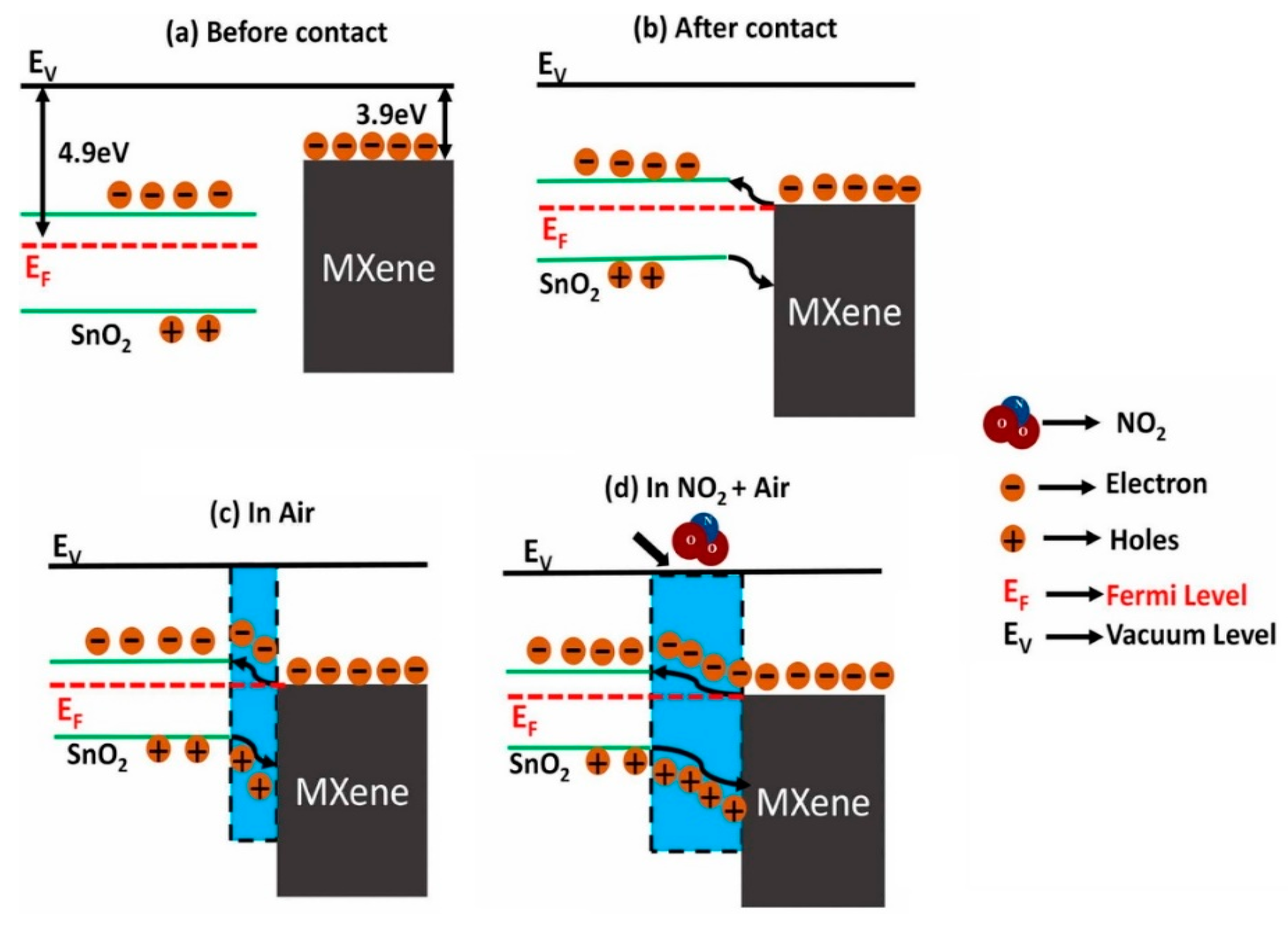




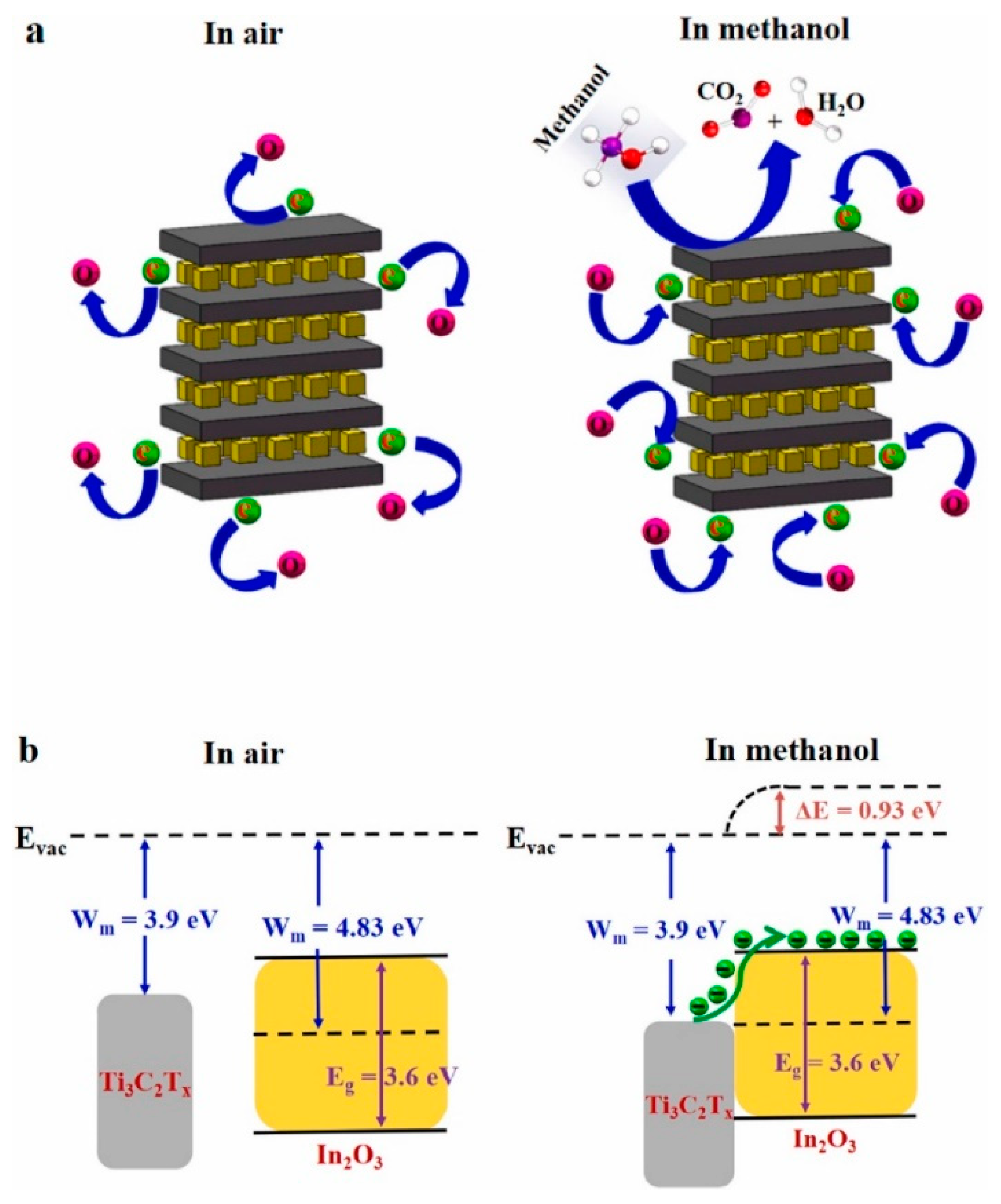
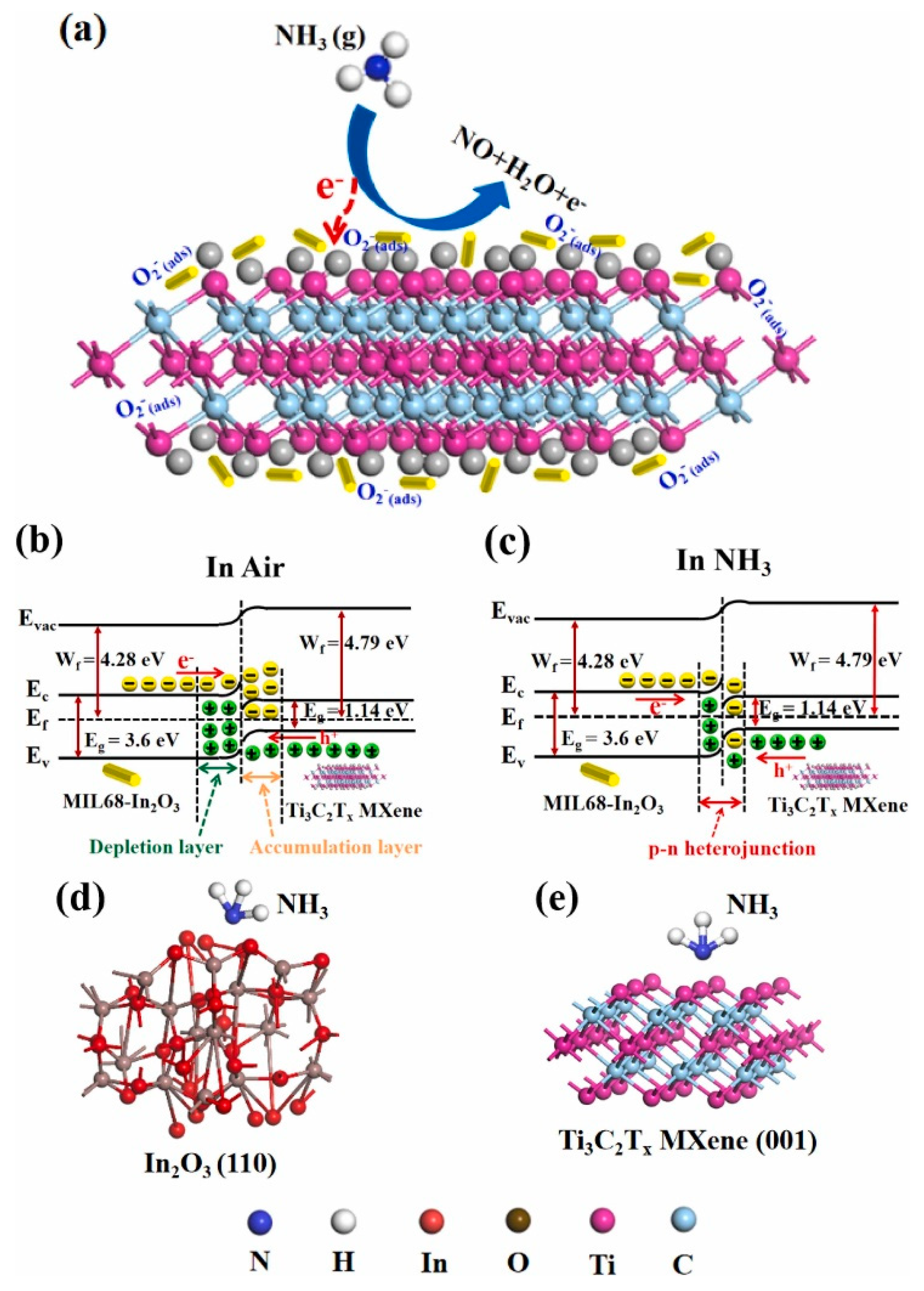




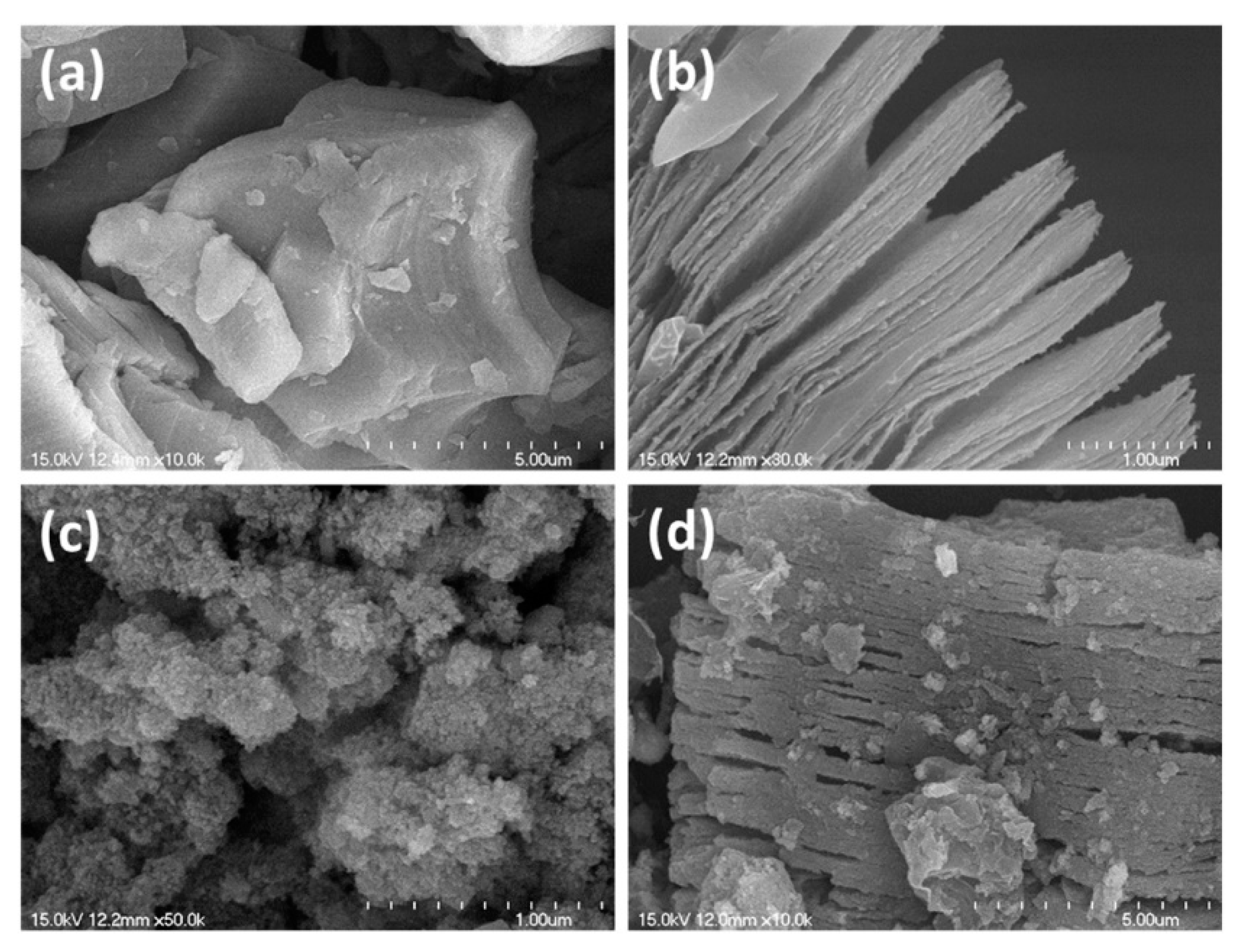

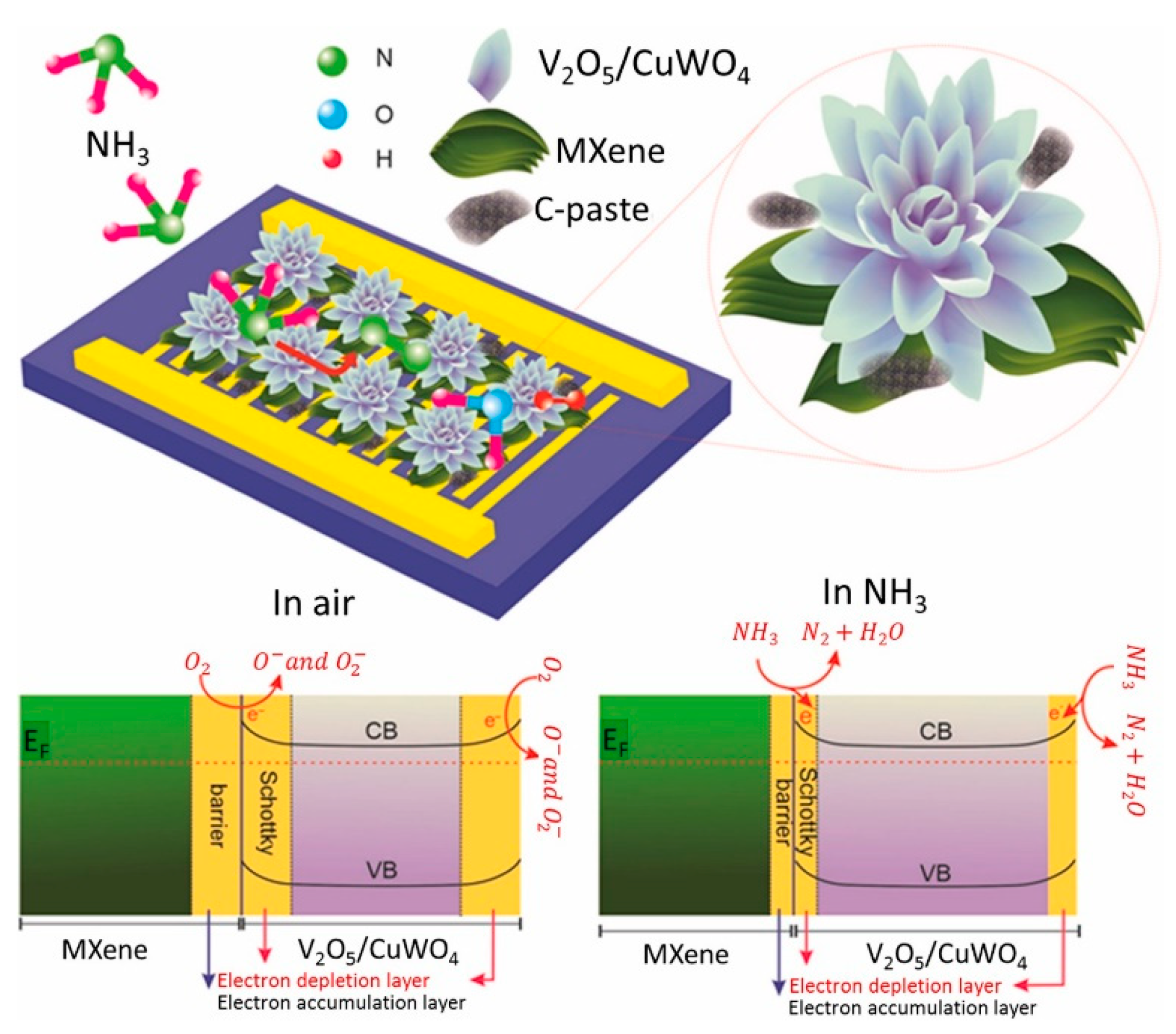
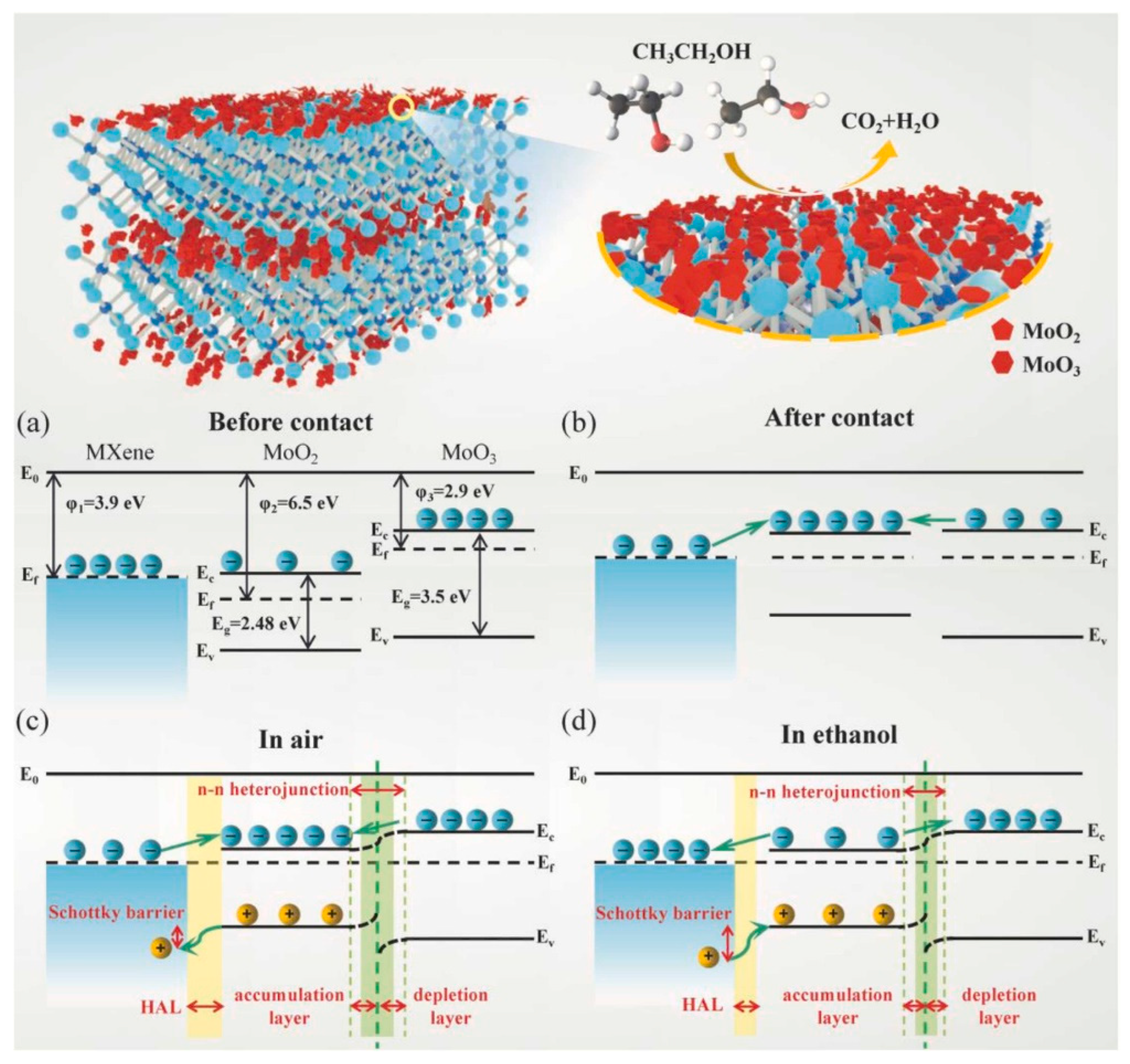
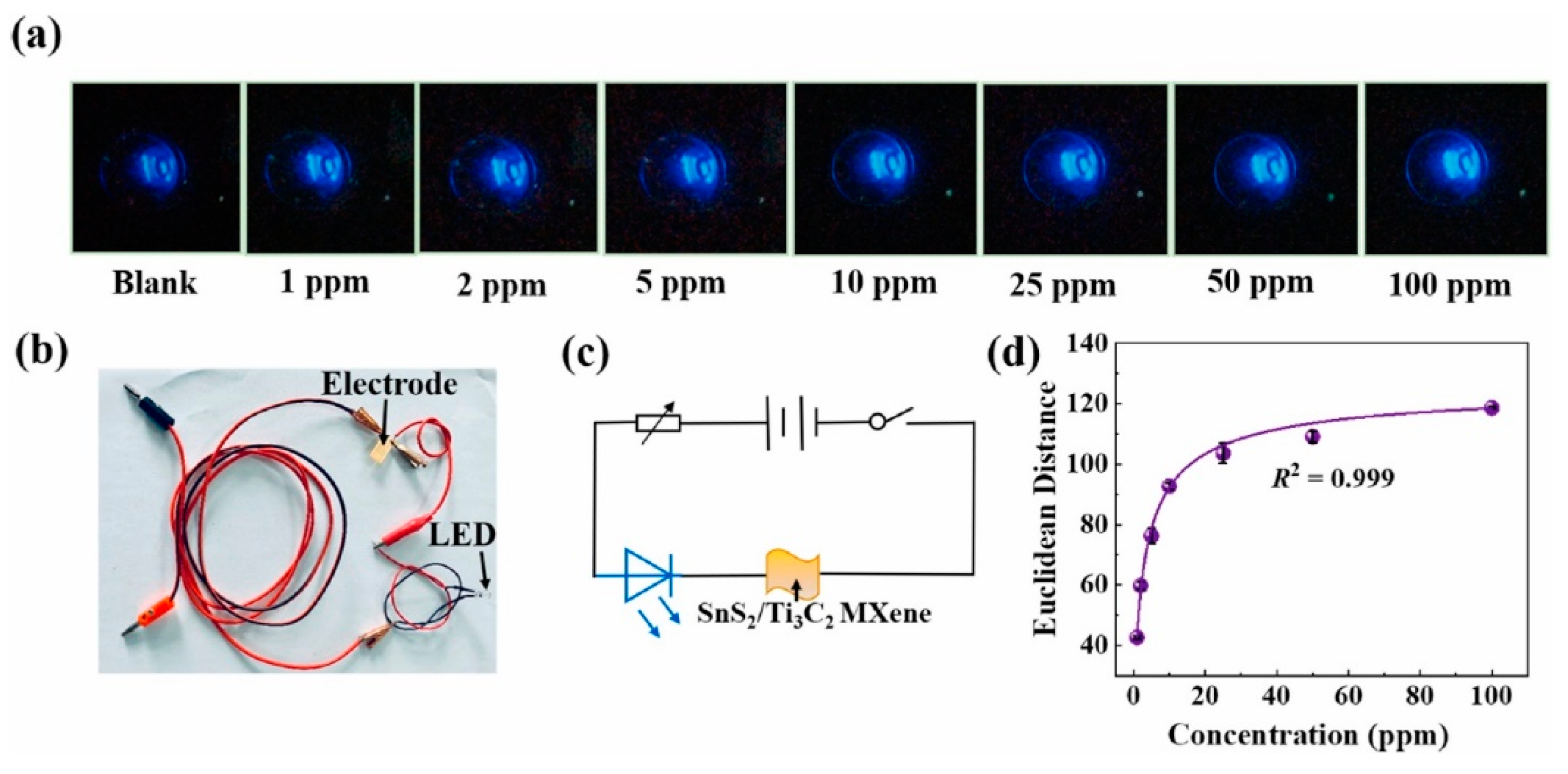

| Sensing Material | Gas | Conc. (ppm) | Response (%) ([(|Rg − Ra|)/Ra] × 100) | Ref. |
|---|---|---|---|---|
| Pristine Ti3C2Tx | NH3 | 100 | 21% | [51] |
| Pristine Ti3C2Tx | NH3 | 500 | 6 | [56] |
| Plasma-exposed Ti3C2Tx | NO2 | 10 | 13.8 | [57] |
| Surface-modified Ti3C2Tx | Ethanol | 20 | 8 | [59] |
| Surface-modified Ti3C2Tx | NO2 | 25 | 26.8 | [60] |
| Pristine Ti3C2Tx | Acetone | 100 | 100 | [68] |
| Mo2CTx | CO2 | 50 | 2.3 | [69] |
| Sensing Material | Gas | Conc. (ppm) | Response (%) ([(|Rg − Ra|)/Ra] × 100) | Ref. |
|---|---|---|---|---|
| SnO2/Ti3C2Tx composite | NH3 | 40 | 40 | [75] |
| Ti3C2Tx-SnO2 composite | NH3 | 100 | 3.1 | [78] |
| NiO/Ti3C2Tx MXene nanocomposites | NH3 | 50 | 6.13 | [79] |
| Ti3C2Tx MXene (30–100 wt%)/In2O3 composite | NH3 | 20 | 100 | [81] |
| In2O3 nanocubes/Ti3C2Tx MXene composites | Methanol | 5 | 29.6 | [83] |
| Hollow In2O3 microbutes (2–5 µm) were attached on the exfoliated Ti3C2Tx MXene | NH3 | 5 | 60.6 | [84] |
| α-Fe2O3/Ti3C2Tx MXene | Acetone | 5 | 16.6 | [85] |
| Rose-like α-Fe2O3/Ti3C2Tx MXene composite | NH3 | 5 | 18.3 | [86] |
| Ti3C2Tx/WO3 nanocomposite | NO2 | 0.2 | 78 | [87] |
| WO3—Ti3C2Tx nanocomposite | NH3 | 1 | 22.3 | [88] |
| Ti3C2Tx MXene/CuO | NH3 | 5 | 46.7 | [89] |
| Ti3C2Tx/CuO nanocomposites | NO2 | 50 | 57 | [90] |
| V2CTx/V3O7 nanocomposites | NO2 | 100 | 16 | [91] |
| Ti3C2Tx MXene/ZnO NRs | NO2 | 0.2 | 346 | [94] |
| Ti3C2Tx-ZnO nanocomposite | NO2 | 20 | 367.63 | [96] |
| ZnSnO3/Ti3C2Tx MXene composite | HCHO | 100 | 194.7 | [98] |
| Ti3C2Tx-WSe2 composite | Ethanol | 40 | 9 | [101] |
| MoS2/Ti3C2Tx composite | NH3 | 20 | 45 | [103] |
| MoS2/Ti3C2Tx composite | NO2 | 100 | 65.6 | [104] |
| T3C2Tx/WS2 nanocomposites | NO2 | 2 | 55.6 | [105] |
| Ti3C2-MoS2 composite | NO2 | 10 | 35.8 | [106] |
| PEDOT and PSS on Ti3C2Tx MXene | NH3 | 100 | 36.6 | [110] |
| PANI NPs Ti3C2Tx NSs | Ethanol | 100 | 27.4 | [112] |
| CPAM/Ti3C2Tx MXene composite | NH3 | 100 | 25 | [116] |
| Ti3C2Tx MXene@TiO2/MoS2 composite | NH3 | 100 | 164 | [117] |
| Ti3C2Tx MXene/rGO/SnO2 aerogel | HCHO | 10 | 54.9 | [120] |
| Ni(OH)2/Ti3C2Tx composite | NH3 | 50 | 13 | [122] |
| SnS2/Ti3C2Tx MXene composite | Acetone | 50 | 29.8 | [124] |
| Sensing Material | Gas | Conc. (ppm) | Response (%) ([(|Rg − Ra|)/Ra] × 100) | Ref. |
|---|---|---|---|---|
| S-doped Ti3C2Tx MXene | C7H8 | 1 | 214 | [127] |
| N-doped Ti3C2Tx MXene-PEDOT:PSS | NH3 | 25 | 25 | [128] |
| Au-decorated α-Fe2O3/Ti3C2Tx MXene | NH3 | 1 | 16.9 | [129] |
| Au-decorated In2O3/Ti3C2Tx MXene composite | HCHO | 5 | 31 | [130] |
Disclaimer/Publisher’s Note: The statements, opinions and data contained in all publications are solely those of the individual author(s) and contributor(s) and not of MDPI and/or the editor(s). MDPI and/or the editor(s) disclaim responsibility for any injury to people or property resulting from any ideas, methods, instructions or products referred to in the content. |
© 2023 by the authors. Licensee MDPI, Basel, Switzerland. This article is an open access article distributed under the terms and conditions of the Creative Commons Attribution (CC BY) license (https://creativecommons.org/licenses/by/4.0/).
Share and Cite
Mirzaei, A.; Lee, M.H.; Safaeian, H.; Kim, T.-U.; Kim, J.-Y.; Kim, H.W.; Kim, S.S. Room Temperature Chemiresistive Gas Sensors Based on 2D MXenes. Sensors 2023, 23, 8829. https://doi.org/10.3390/s23218829
Mirzaei A, Lee MH, Safaeian H, Kim T-U, Kim J-Y, Kim HW, Kim SS. Room Temperature Chemiresistive Gas Sensors Based on 2D MXenes. Sensors. 2023; 23(21):8829. https://doi.org/10.3390/s23218829
Chicago/Turabian StyleMirzaei, Ali, Myoung Hoon Lee, Haniyeh Safaeian, Tae-Un Kim, Jin-Young Kim, Hyoun Woo Kim, and Sang Sub Kim. 2023. "Room Temperature Chemiresistive Gas Sensors Based on 2D MXenes" Sensors 23, no. 21: 8829. https://doi.org/10.3390/s23218829
APA StyleMirzaei, A., Lee, M. H., Safaeian, H., Kim, T.-U., Kim, J.-Y., Kim, H. W., & Kim, S. S. (2023). Room Temperature Chemiresistive Gas Sensors Based on 2D MXenes. Sensors, 23(21), 8829. https://doi.org/10.3390/s23218829









